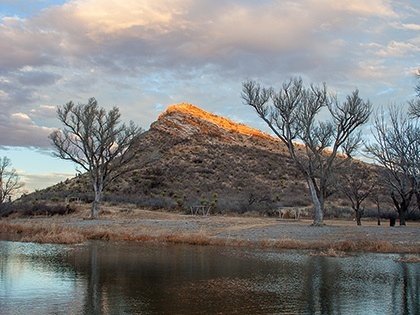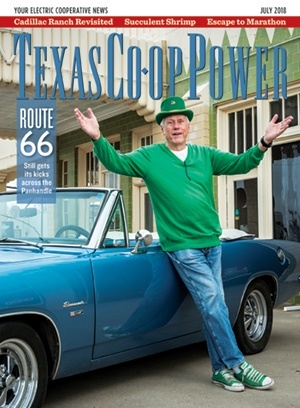Dry. Dusty. Desolate. We’ve just pulled up alongside a century-old cottage on Avenue J in Marathon, and the desert scenery’s definitely not inviting. The house looks iffy, too. I can already sense that my husband wishes he hadn’t agreed to this last-minute trip.
Past the iron garden gate, Mexican feathergrass tickles our bare legs as we carry our stuff across the flagstone path and up the front steps of La Esmeralda.
“Look, James, a glider!” I’m hopeful that the screened porch’s rusted vintage sofa with red cushions will charm my dubious husband (and redeem me). We unload our suitcases and supplies. Then we nose around the house, decorated cowboy-modern style. Ceiling fans, modern kitchen appliances and central air mesh well with the home’s wood floors and claw-foot tub. Built-in bookcases contain an eclectic library that includes acclaimed Texas authors. I can’t wait to browse.
In the yard, native wildflowers, prickly pear cacti, yuccas and cenizo replicate the surrounding Chihuahuan Desert. Several carpenter bees, black and shiny, patrol a dead agave stem, where they’ve tunneled nest holes. Binoculars in hand, I sit down on a rock bench and watch a black-throated sparrow as it lands at the rock-bordered fish pond for a sip.
Next, we set out to explore Marathon, Brewster County’s second-largest town, with a population of 430. A downtown stroll takes us past the post office as well as art galleries, shops and a cafe. I tug James toward the historic Gage Hotel.
In 1927, San Antonio businessman Alfred S. Gage built the two-story, terra-cotta brick hotel as headquarters for his local ranching and banking interests. We slip inside the lobby for a sample of the hotel’s luxurious, Spanish-flavored décor.
Around the corner, we spy the tin-roofed French Co. Grocer, named after a mercantile store that operated 72 years in Marathon. Some motorcyclists have just plunked down with their drinks at one of the picnic tables on the covered concrete porch. Inside, French’s stocks everything from ketchup to camping gear. We look over prepackaged sandwiches and salads in the cooler then buy a loaf of homemade bread.
Across the railroad tracks, we’re surprised to find a 27-acre oasis called Gage Gardens. A crushed granite path winds through columbines, santolina, red hot pokers, yuccas, oaks and retamas. We also check out a rose garden, fountains and a pond, not to mention a nine-hole putting green. Where’d the desert go?
But wait. A side trip 5 miles south of Marathon turns up yet another surprise: a secluded green spot known as Post Park. Shaded by huge cottonwoods and oaks, picnic tables and a concrete dance pavilion overlook a spring-fed pond. In the 1880s, the watering hole supplied a U.S. Army post. Now, a quartet of ducks hurriedly paddle our way in hopes of a handout, and nearby, a pair of summer tanagers flit from branch to branch.
Back at the house, James cooks up supper. At a wooden table on the screened porch, we savor broiled salmon, corn on the cob and French’s bread. Our eastward view of distant hills, silhouetted against the evening sky, gradually melts into starry darkness. After supper, we relax on the porch and listen to soft classical music.
Early the next day, we’re back on the porch, armed with cameras and steaming cups of coffee. A mockingbird calls from high atop the cottonwood that stands near the back door. Soon, the morning’s first burnt-orange sunrays halo over the hills. “So,” James says from his seat on the glider, “how about we stay an extra night?” I smile. I’m pretty sure I’ve been redeemed.
Sheryl Smith-Rodgers, a member of Pedernales EC, lives in Blanco.


